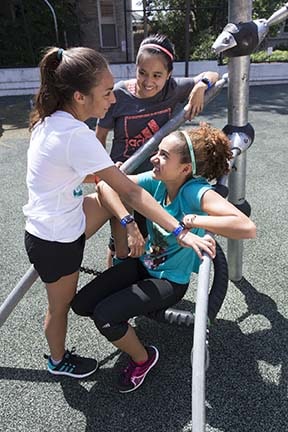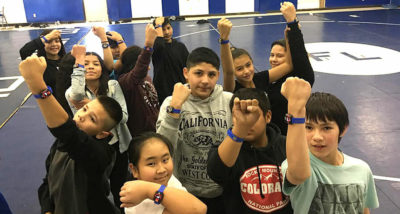Creating Positive, Engaging Memories Essential After Study Links Negative Experiences with Sedentary Adult Behavior
New research details how students’ perception of their PE experience in school correlates to their level of healthy activities as adults. The IHT Spirit heart rate training system helps teachers create positive experiences in PE by giving students objective assessment of progress towards goals that empowers students to self-manage their fitness.
Earlier this year, the American College of Sports Medicine published a study conducted by Matthew A. Ladwig, Spyridoula Vazou, and Panteleimon Ekkekakis that links sedentary behavior in adults to negative memories of their physical education classes.
“Adults hold remarkably vivid positive and negative memories of PE from their childhood, which may, to some extent, continue to influence their present-day attitudes, intentions and behavior,” writes Ladwig and team in their study titled “’My Best Memory Is When I Was Done With It’: PE Memories Are Associated with Adult Sedentary Behavior.”
In evaluating responses from more than 1,000 participants, Ladwig reports that negative memories of PE – embarrassment being the primary negative memory – weigh more on attitudes of adults than positive experiences in PE.
“The worst memories reported in this survey may have important implications because memories for negative experiences, especially those with a strong ego-related emotional component, are typically more salient than memories for positive experiences when engaging in decision making,” Ladwig writes.
Sixty percent of the respondents – aged 18-45 – had more vivid negative PE memories that impact their exercise routines as adults. The findings represent the opposite of what the 21st century PE teacher wants to accomplish.
“Lifetime fitness is the foundation that they need to strive for,” said Lindsay Yost, health and PE teacher at Fort Lupton (Colo.) Middle School. “Even though I’m in the health classroom, I’m constantly bringing in who I am and what I do and trying to set an example that these kids can buy into and continue with for the rest of their lives.”
To ensure students have positive experiences in PE – and thus are more likely to remain active as adults – teachers employ several key strategies:
- Introduce and embrace new technology that personalizes student-driven learning, including the IHT Spirit System;
- Create an environment where each student can find success;
- Give students ownership of their workouts.
Embracing Personalized PE Heart Rate Technology
 In 2016, IHT introduced its new wrist-based heart rate monitor — the IHT ZONE — that allows students a real-time look at their heart rate during exercise. Developed specifically for education, the IHT ZONE shows students their actual heart rate and the heart rate zone – based on exertion level – in which they are exercising: blue, yellow and red, with yellow and red indicating primary target zones for moderate to vigorous physical activity.
In 2016, IHT introduced its new wrist-based heart rate monitor — the IHT ZONE — that allows students a real-time look at their heart rate during exercise. Developed specifically for education, the IHT ZONE shows students their actual heart rate and the heart rate zone – based on exertion level – in which they are exercising: blue, yellow and red, with yellow and red indicating primary target zones for moderate to vigorous physical activity.
“My students have never been more motivated to ‘get in their zone’ before,” said River Rock Intermediate School (Wisc.) PE teacher Jackie Clark. “Students are able to monitor their heart rate throughout the entire class period with the heart rate display accessible to them any time.”
Students at schools utilizing the Spirit System learn to manage their fitness by exercising at an elevated heart rate. They wear the IHT ZONE heart rate monitor during class and, along with their parents, receive detailed reports analyzing their heart rate throughout their workout immediately following class. Students work with teachers to understand the reports which detail how many minutes each student spent exercising at a moderate to vigorous physical activity level.
“Children and adolescents aged 6 to 17 years should have 60 minutes (1 hour) or more of physical activity each day,” states the CDC, which continues that “most of the 60 or more minutes a day should be either moderate- or vigorous-intensity aerobic physical activity and should include vigorous-intensity physical activity at least 3 days a week.”
Students also learn the essential skill of utilizing a heart rate monitor, a skill they can rely on as they develop their own exercise routines as adults.
“The kids having this technology so young is very exciting,” Yost said. “They’ll be able to take that knowledge and use it as an adult. Whatever their activity may be, as an adult, having the knowledge and the desire to know how a heart rate monitor works will be a huge skill set that they can carry on with them.”
Creating Positive Experiences in PE
When many of the survey respondents took PE in school, teachers simply provided balls with which students could play games or had students run or perform different calisthenics. Students who couldn’t perform tasks as well as others either received lower grades, were left out, or, in extreme and isolated instances, were embarrassed for their lack of success. Ladwig’s study cited embarrassment as the primary negative memory.
By individualizing PE with heart rate monitors, IHT Spirit System teachers motivate students to continue working toward fitness goals they can attain individually.
“Students learn at the beginning of the school year that everybody has their own best,” said Hampstead (NH) Middle School teacher Kate Muskat. “While it might look to you that somebody might not be trying their hardest, that might be all they have.”
A health teacher, Muskrat brings her students to the gym each Friday for a high-intensity interval training workout. After evaluating different types of workouts, she chose HIIT because the circuit-based workout includes different fitness elements all students can relate to.
“This just seems like something that allows everyone to achieve greatness,” she said. “This tailors to an individual’s need instead of some of the other things we’ve tried.”
Encouraging Student Ownership of Fitness
By allowing – and encouraging – students to develop their own workouts, teachers help students gain the intrinsic skills they’ll need to remain healthy as adults.
Oskaloosa (Iowa) Middle School PE teacher Betsy Luck puts her students in charge of their own workouts each Wednesday. She sets out equipment for students to utilize, but they have the freedom to craft their own workouts.
“They have to choose the activity that’s going to help them get in the target heart rate zone during the class period,” she said. “They can make all the choices in the world that they want to, it’s up to them to create a workout that will help them reach their goal.”
When given the freedom to craft their own routine, students routinely achieve their goals for time spent exercising at an elevated heart rate. At East High School in Lincoln, Neb., Kara Foster’s students didn’t want to participate in a workout the teacher created, so they asked if they could work on their fitness independently.
“We tell them that we want to work on their personal fitness,” Foster said. “Again, it’s that choice. They knew what they wanted to do for their 30 minutes to get up in the target zone. Each of them met their goal that day. It was a complete independent workout and they met those goals.”
By transitioning from more outdated practices to a fitness-based curriculum, teachers can help students create more positive experiences in PE, thus keeping students engaged with their fitness as they become adults.
“I’ve been teaching physical education for almost 28 years now,” said Lunenburg (Mass.) High School teacher Steve Boone. “I think students overall like this type of class better than your traditional, old-school physical education class. I think they like individual workouts. They like to push themselves.”
Seeking IHT Spirit System information?





